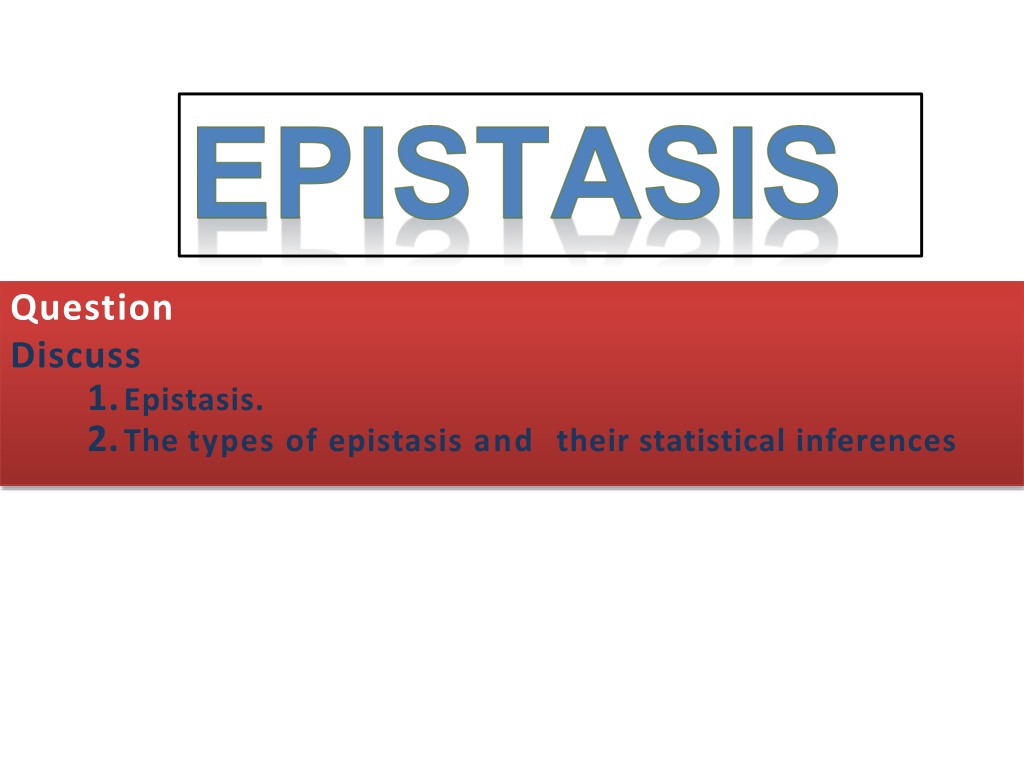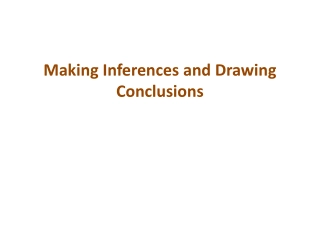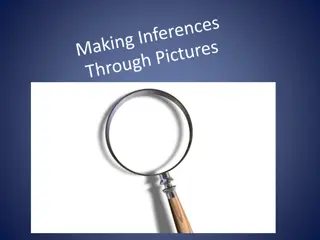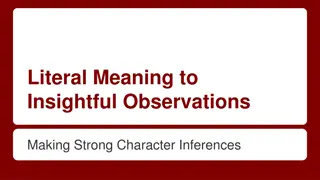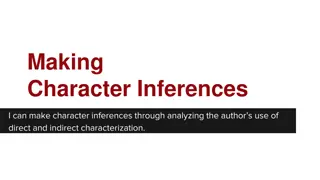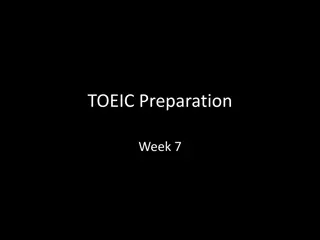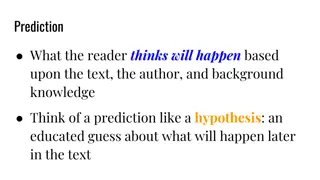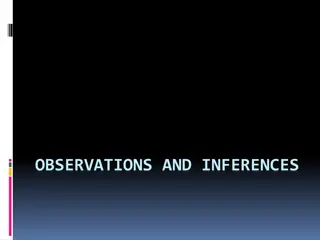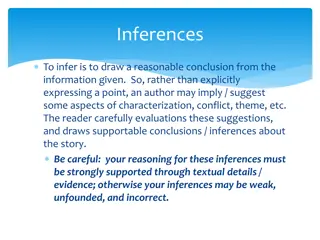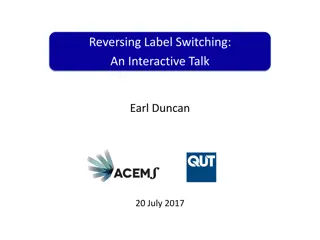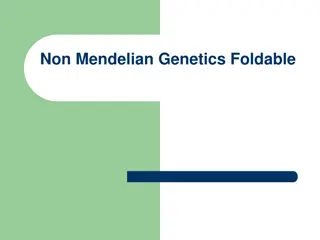Understanding Epistasis: Types and Inferences
Epistasis is the interaction between genes where one gene's allele masks the expression of another gene. Various types of epistasis, such as dominant and recessive epistasis, can be observed, impacting the phenotypic ratios. Statistical inferences can help analyze epistatic interactions in genetic studies.
Download Presentation

Please find below an Image/Link to download the presentation.
The content on the website is provided AS IS for your information and personal use only. It may not be sold, licensed, or shared on other websites without obtaining consent from the author. Download presentation by click this link. If you encounter any issues during the download, it is possible that the publisher has removed the file from their server.
E N D
Presentation Transcript
Question Discuss 1.Epistasis. 2.The types of epistasis and their statistical inferences
iin nt tr ro od du uc ct tio ion n Epistasis is a Greek word that means standing over. Bateson used it to describe the masking effect in 1909. Definition of epistasis: "An interaction between a pair of genes where an allele of one gene hides or masks the visible output, or phenotypic expression of another gene at another locus Genes whose phenotypes are ; Expressed are called epistatic genes. Suppressed are called hypostatic genes.
Epistasis is the phenomenon when one allele of a gene masks the expression of alleles of another gene. The masking of the phenotypic effect of alleles of one gene by alleles of another gene. A gene is said to be epistatic when its presence suppresses the effect of a gene at another locus. Epistatic genes are sometimes called inhibiting genes because of their suppressed effect on other genes that are described as hypostatic. Epistatic genes can be either a dominant allele or homozygous recessive allele.
Difference between dominance and epistasis Dominance Epistasis Involves intra-allelic gene interaction. Involves inter-allelic gene interaction. One allele hides the effect of One gene hides the effect of other allele at the same gene other gene at different gene loci. pair.
Kinds of EpistaticInteractions In epistasis less than four phenotypes appear in F2. ( ) Dominant Epistasis (12:3:1) (ii) Recessive epistasis (Supplementary gene interaction)(9:3:4). (iii) Duplicate Recessive Genes (9:7) (Complementary Genes) (iv) Duplicate Dominant Genes / Duplicate genes (15:1). (v) Duplicate Genes with Cumulative Effect/Additive genes (9:6:1). (vi) Dominant Recessive Interaction/Inhibitory genes (13:3).
1. Dominant Epistasis. (12:3:1) When a dominant allele at one locus can mask the expression of both alleles (dominant and recessive) at another locus, it is known as dominant epistasis. This is also referred to as simple epistasis. This type of dominant epistasis modifies the classical ratio of 9:3:3:1 into 12:3:1
Example: Studied in summer squash (Cucurbita pepo) An example of dominant epistasis is found for fruit colour in summer squash. There are three types of fruit colours in this cucumber, viz., white, yellow and green. White colour is controlled by dominant gene W and yellow colour by dominant gene G. White is dominant over both yellow and green.
The green fruits are produced in recessive condition (wwgg). A cross between plants having white and yellow fruits produced F1 with white fruits. Inter-mating of F1plants produced plants with white, yellow and green coloured fruits in F2in 12 : 3 : 1 ratio
The effect of dominant gene Y is masked by the dominant gene W (epistatic gene) P WWYY X wwyy (white) (green) F1 (white) (selfed) F2 White:Yellow:Green 12 : 3 : 1 WY Wy wY wy / WY WWYY WWYy WwYY WwY y WwYy Wy WWYy WWyy WwYy Wwy y wY WwYY WwYy wwYY wwY y wy WwYy Wwyy wwYy wwy y
2. Recessive epistasis (9:3:4) (Supplementary interaction) When recessive alleles at one locus mask the expression of both (dominant and recessive) alleles at another locus, it is known as recessive epistasis. interaction is also known as supplementary epistasis. This type of gene
In horses, brown coat color (B) is dominant over tan (b). However, phenotype is dependent on a second gene that controls the deposition of pigment in hair. how that gene is expressed in the The dominant gene (C) codes for the presence of pigment in hair, whereas the recessive gene (c) codes for the absence of pigment.
3. Duplicate Recessive Genes (9:7) (Complementary Genes) Non allelic dominant genes when present together produces a phenotype different from that produced by either alone. Both dominant alleles, when present together, complement each other and produce a different phenotype. In other words, homozygous recessive alleles at both loci either alone or together produces identical phenotypes, the F2 ratio becomes 9:7. The genotypes aa B-, A-bb and aabb produce one phenotype.
ExaEmxpalemple Bateson and Punnett observed that when two white flowered varieties of sweet pea, Lathyrus odoratus were crossed, F1progeny had purple flowers. When F1was selfed, the F2ratio showed the presence of both purple and white flowered varieties in the ratio 9:7. The purple colour of flower in sweet pea is governed by two dominant genes say A and B. When these genes are in separate individuals (AAbb or aaBB) or recessive (aabb) they produce white flower. Other examples are; Maize colour Human mutism Etc.
In this case dominant alleles on both locus are required hence wherever A and B both are present they result into purple effect masking the white. This is because A and B alleles modified the colorless precursor by showing their effects
4. Duplicate Dominant Genes. (15:1) If a dominant allele of both gene loci either alone or together produces the same phenotype without cumulative effect, i.e., independently the ratio will be 15:1. It is also called duplicate gene interaction. They are identical genes but are situated on two different pairs of chromosomes. The duplicate genes are also called pseudoalleles.
Example A good example of duplicate dominant epistasisis awn character in rice. Development of awn in rice is controlled by two dominant duplicate genes (A and B). Presence of any of these two alleles can produce awn. The awnless condition develops only when both these genes are in homozygous recessive state (aabb). A cross between awned and awnless strains produced awned plants in F1. Inter-mating of F1 plants produced awned and awnless plants in 15 : 1 ratio in F2generation
The allele A is epistatic to B/b alleles and all plants having allele A will develop awn. Another dominantallele B is epistatic to alleles A/a. Individuals with this allele also will develop awn character. Hence in F2, plants with A-B-(9/16), A-bb-(3/16) and aaB-(3/16) genotypes will develop awn.
The awnless condition will develop only in double recessive (aabb) genotype (1/16). In this way only two classes of plants are developed and the normal dihybrid segregation ratio 9 : 3 : 3 : 1 is modified to 15 : 1 ratio in F2. Similar gene action is found for nodulation in peanut and non-floating character in rice.
5. Duplicate Genes with Cumulative Effect. (9:6:1) Two dominant genes at both loci have similar effect when they are alone, but produced enhanced effect when they come together. Such gene interaction is known as duplicate genes with cumulative effect. Also called Additive gene interaction /Polymeric gene action In the absence of any dominant recessive alleleis expressed. allele, the
Example A well-known example of polymeric gene interaction is fruit shape in summer squash. There are three types of fruit shape in this plant, viz., disc, spherical and long. The disc shape is controlled by two dominant genes (A and B), the spherical shape is produced by either dominant allele (A or B) and long shaped fruits develop in double recessive (aabb) plants.
A cross between disc shape (AABB) and long shape (aabb) strains produced disc shape fruits in F1. Inter- mating of F1plants produced plants with disc, spherical and long shape fruits in 9 : 6 : 1 ratio in F2
Here plants with AB(9/16) genotypes produce disc shape fruits, those with A-bb- (3/16) and aaB-(3/16) genotypes produce spherical fruits, and plants with aabb (1/16) genotype produce long fruits. Thus in F2, normal dihybrid segregation ratio 9:3:3: 1 is modified to 9 : 6 : 1 ratio. Similar gene action is also found in barley for awn length.
6. Inhibitory gene action (13:3) In this type of epistasis, a dominant allele at one locus can mask the expression of both (dominant and recessive) alleles at second locus. Here this gene is called inhibitory gene as it is capable of inhibiting the production of purple colour. Plants are purple, only if they possess the gene for purple colour, in the absence of the inhibitory gene. This is also known as inhibitory gene interaction. An example of this type of gene interaction is found for anthocyanin pigmentation in rice.
Example The green colour of plants is governed by the gene I which is dominant over purple colour. The purple colour is controlled by a dominant gene P. When a cross was made between green (IIpp) and purple (iiPP) colour plants, the F1 was green. Inter-mating of F1 plants produced green and purple plants in 13 : 3 ratio in F2. This can be explained as follows.
Here the allele I isepistatic to alleles P and p. Hence in F2, plants with I-P- (9/16), I-pp (3/16) and iipp (1/16) genotypes will be green because I will mask the effect of P or p. Plants with iiP-(3/16) will be purple, because I is absent.
In this way the normal dihybrid segregation ratio 9 : 3 : 3 : 1 is modified to 13 : 3 ratio. Similar gene interaction is found for grain colour in maize, plumage colour in poultry and certain characters in other crop species.
